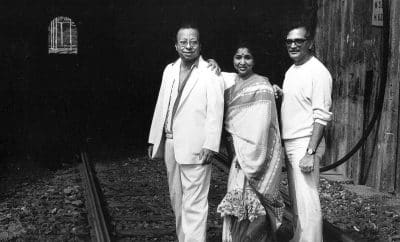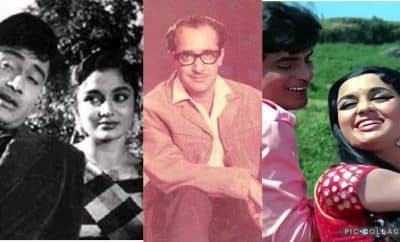Legends
R D Burman – The Composer Who Broke The Mould
It was sometime in mid sixties during the meetings of Cine Music Artists Association, someone asked composer Jaikishan about his views on his contemporaries. Jaikishan very candidly told that the kind of experiments with sound Pancham is doing, in coming years, he will leave everyone behind. Perhaps he saw what was coming. It was Pancham who was arriving on the scene of Hindi Film Music.
Music composition in Hindi Films was already almost three decades old by the time Pancham arrived. Influences of Anil Biswas and Naushad in style of composition had guided many subsequent composers. There were few game changers too like Shankar Jaikishan and O.P.Nayyar but one composer who completely changed the way composition and arrangement was being practiced was Rahul Dev Burman.
When we speak of music composition and arrangement, we speak of not only making a song but also its orchestration, sound design and recording techniques. Also, blending of composition with its cinematic canvas in the film was equally important. Pancham excelled in all these departments but he never followed suit. He charted his own ways which later became a template for new generation composers.
It would be very interesting to know how he did these innovations. Let’s have a closer look at a few of his compositions and understand them.
Kya Jaanu Sajan – Baharon Ke Sapne (1967)
While the film industry had a major breakthrough in the 60’s decade in terms of transition from black and white to colour films, one area was still in its infancy and that was sound recording facilities. Multi track recording and mixing was still a few years away. However the dreamer Pancham did find their way from available means and made it possible at least for one song.
In the film Baharon Ke Sapne, Pancham experimented with the use of Sound on Sound technique for the first time. In the song Kya Jaanu Sajan Hoti Hai Kya Gham Ki Shaam, he used the voice of Lata Mangeshkar as an overlapping harmony on her own voice and the result was amazing. But how did he achieve this without a track mixing facility in 1967? Well, he was as competent in musical technology as he was in music.
In the 60’s, sound was recorded on magnetic tapes through a recording system wherein there used to be two heads – a recording head and an eraser head. If a sound was to be recorded, magnetic tape had to be passed through the recording head and sound signals used to get captured on tape through it. However, if another sound had to be recorded on the same tape, in the machine an eraser head also used to get pressed on tape along with the recording head so that previously recorded sound gets erased and new sound can be recorded simultaneously. Pancham got the eraser head removed and recorded Lata Mangeshkar’s voice at certain places for harmony in the pre-recorded song which was in her own voice. Thus, her voice was recorded as an overlap on her own previously recorded voice. What a brilliant way of using sound on sound.
Dilbar Dil Se Pyare – Caravan (1971)
https://youtu.be/w7gP0JYH5do
Community folk music compositions always had chorus as an integral element. People getting together singing and dancing brings about the spirit of unity. Our composers have always used Chorus in their songs.
However, Choral sound can be used as harmony also that people knew from Pancham. Before him chorus was largely used as either complementing sound to main vocals or choir sound was used as fillers some times by experimental Composers like Salil Chowdhury.
Pancham kept disrupting sound designs of his father’s compositions also with his brilliant ideas. First glimpse of such an idea in the chorus was perhaps in Khwab Ho Tum.
Here, in this gypsy theme based melody, male and female chorus is used separately like a bass and treble clef. Also, the short humming fillers of the female chorus replaced the instrument filler and enhanced the feel of nomadic folk song. One more very interesting experiment is male chorus and female chorus repeating lines interchangeably. For Example, Mohe Chhu Le Sajnaa (Repeat – Sajnaa by female chorus), Gussa Kyun Hai Itnaa ( Repeat – Itnaa by Male Chorus). This was a new concept of using different chorus sounds in each line and it made the composition absolutely interesting.
Apart from the chorus, this song is a brilliant piece of work in rhythm guitar-ing also.
Tere Sau Diwane – Shareef Badmash (1973)
https://youtu.be/tAmRN9Uj1kw
One of his biggest contributions to the sound of film songs is bass guitar. His love for bass sound and designing of bass lines around rhythm was brilliant and innovative. His sound balancing was so precise that we can identify bass separately. Why ? Because while he elevated the sound of bass guitar to the level of rhythm, he muted the bass sound of rhythm and let only the flat non resonating rhythm beats get audible. This would seamlessly blend bass guitar with rhythm.
This is quite noticeable in the song ‘Tere Sau Deewane……‘……the song begins with a prelude on guitars and bongo for four bars (on 2/4 beats) and from the fifth bar, the bass riff starts and we can immediately spot the difference in listening. It brings an energy into the composition.
Another point of his experiment in this song is using Palm Muffling on Guitar in the prelude. In the first four bars the prelude is played on guitar using Muffling technique (damping the sound by palm of hands and playing). Remember the prelude of Waadiyan Mera Daman in which he used the same immediately before accordion starts. Using such a sound for the prelude was a new experiment in the early 70’s.
We can also spot Piano comping in the background in this song very clearly.
O Majhi Re Jaayen Kahan – Bandhe Haath (1973)
Those composers who could find opportunity in a tricky situation for songs could create wonders and Pancham was unquestionably a genius when it came to blend cinematic expressions with music.
His approach for orchestration and developing the composition always centred around the situation in the film. Now if such a composer comes across a situation wherein the theme of the song is of fishermen and women dancing and singing and actually it’s a skit being played on stage, what he could do is ‘O Majhi Re Jayen Kahaan……..‘ in the film Bandhe Haath (1973).
I am sure he could see a lot of scope to fuse multiple genres in this song and hence did all those experiments that are sheet delight. Let’s take a look.
The song begins with a humming melody of chorus and quickly it turns into harmony with strings. Here, he used the humming of the chorus in bass voice as a harmony with violins. Replacement of Viola and cellos !!! Later on the same choral harmony is also used as an Obbligato in the background of Asha Bhosle’s vocals.
The rhythm played is soul beats on drums. Who could have imagined soul beats with a fisherman folk flavour song ? Only Pancham. In the antara, the flute filler gives a bit of bhatiyali flavour. Interplay of Taar Shehnai and Flute in the second interlude is again a brilliant example of his way of bringing out the emotions of the song keeping in mind the situation. Since the fisher woman is singing and remembering her beloved, she is sad. Her pathos are perfectly brought out with the Taar Shehnai and Flute pieces.
This could be one of his highly experimented and underrated compositions.
Huzur Iss Kadar – Masoom (1983)
https://youtu.be/PNPX8mM0dnI
Pancham began his training in music by learning Tabla. His most of the rhythm innovations could be credited to his training in classical rhythm. He not only learnt but also became equally deft at applying his knowledge in the most innovative way. This song is one such example of his way of using Taal Dadra in his own way. Taal Dadra in Indian Music and Waltz beats in western music are technically the same in terms of no. of beats and cycle.
Essentially Waltz being a dance form had cyclical beats that had no variation. In western theory it is known as 3/4 time signature. The beats are 1-2-3/1-2-3.
It’s indian counterpart is Taal Dadra. Perfectly fitting into the waltz beats format with its six beats cycle as below :
DHA DHI NA | DHA TI NA
1 2 3 4 5 6
However, the basic difference is that Dadra or for that matter any Taal can be played with many techniques and variations which makes it rich in expression of sound unlike the monotonic cycle of beats in western music.
This song Huzur Iss Kadar Bhi Na Itra Ke Chaliye is a lovely example of Dadra or 3/4 beats played with beautiful variations.
While the song begins with Dadra theka in dugun laya i.e. two beats at a time and smoothly flows on with a lovely variation called laggi (a technique of variation) between 2:08 to 2:16 minutes mark and again comes back to its usual flow.
Brilliantly used Dadra without overpowering the melody.
R.D.Burman would have been perhaps the only composer whose popularity has been increasing even after twenty six years of his passing. Music connoisseurs across continents have appreciated and cherished his work and that is the testimony of his calibre. His innovations and applications of music concepts in most unique ways will keep guiding musicians of coming generations.




sunil mehta
June 28, 2021 at 7:41 pm
Brilliant breakup & analysis of songs. Kudos Kunal